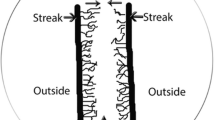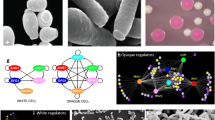Summary
A review of the literature correlated with laboratory studies of the influence of carbon source, temperature, and pH on chlamydospore formation, substantiate the enzymatic hypothesis of morphogenesis inCandida albicans.
Similar content being viewed by others
References
Bakerspigel, A. 1954. Soil-extract agar forCandida albicans. Arch. Derm. Syph.69: 735–737.
Benham, R. W. 1931. Certain Monilias parasitic on man. J. inf. Dis.49: 183–215.
Blyth, W. 1959. Host/parasite relationships in experimental moniliasis. Mycopathol. et Mycol. appl.10: 269–282.
Bradley, S. G. 1958. Effect of Nystatin onCandida stellatoidea. Antibiot. and Chemother.8: 282–286.
Cochrane, V. W. 1958. Physiology of Fungi. NY: John Wiley & Sons, Inc.
Draper, A. A. 1924. Production of mycelial forms byOidium albicans in carrot infusion. J. inf. Dis.34: 631–635.
Falcone, G. &Nickerson, W. J. 1957. Physiological basis of morphogenesis in fungi. 6. Effect of sulfur deficiency in growth and cellular division ofCandida albicans. G. Microbiol.4: 105–118.
——, & ——. 1958. Enzymatic reactions involved in the cellular division of microorganisms. Proc. 4th int. Cong. Biochem., Vienna6: 65–70.
—— & ——. 1960. Metabolism of selenite and mechanism of inhibitory action of selenite on yeasts. G. Microbiol.8: 129–150.
Finneman, B. C. 1921. A study of the thrush parasite. J. inf. Dis.28: 185.
Foster, J. W. 1949. Chemical activities of fungi. NY: Academic Press.
Haley, L. D. &Stonerod, M. H. 1955. A study of method used in the identification ofCandida albicans. Amer. J. med. Tech. 304–308.
Hayes, Alice &Thompson, J. R. 1963. Identification ofCandida albicans. Amer. J. clin. Path.40: 553–555.
Ingram, M. 1955. An introduction to the biology of yeasts. New York: Pitman Company.
Jillson, O. F. &Nickerson, W. J. 1948. Mutual antagonism between pathogenic fungi. Inhibition of dimorphism inCandida albicans. Mycologia40: 369–385.
Johnson, S. A. M., Gusmon, M. G. &Agurlera, C. T. 1954.Candida (Monilia)albicans. Effect of amino acids, glucose, pH, chlortetracycline, dibasic sodium and calcium phosphates, anaerobic conditions on its growth. Arch. Derm. Syph.70: 49–60.
Karassevich, Yu N. 1958. Adaptation of yeasts to pentoses. Microbiologia27: 145–149.
Karczewska, H. 1959. Some observations on pentose utilization byC. tropicalis. C. R. Lab. Carlsberg31: 251–258.
Karnaky, K. J. 1945. At what pH does pathogenicMonilia albicans grow best. Est. J. Surg.53: 390–391.
——. 1956.Monilia (Candida)albicans: a culture and electronic pH study. Amer. J. Obstet. Gynec.71: 391–398.
Kligman, A. 1950. Aids in technic in the identification ofCandida albicans. J. invest. Derm.14: 173–176.
Langeron, M. &Guerra, P. 1940. Orientation de la filamentisation des champignons levuriformes cultivés sur lames gelosées. Ann. Parasit. hum. comp.17: 580–589.
Linossier, G. &Roux, G. 1890. Sur la nutrition du champignon du muguet. C. R. Acad. Sci. Paris.110: 355–358.
Liu, P. &Newton, A. 1955. Rapid chlamydospore formation byCandida albicans in a bufferred alkaline medium. Amer. J. clin. Path.25: 93–101.
Mackenzie, D. W. R. 1964. Morphogenesis ofCandida albicans in vivo. Sabouraudia3: 225–232.
Magni, G. 1948. Biological significance of the pseudomycelium in asporogenous yeasts. Mycopathol. et Mycol. appl.4: 207–212.
Marwin, R. M. 1959. Survey of surface-active culture additives for growth of pathogenic human fungi. Mycologia51: 61–68.
Mazia, D. 1954. SH and Growth, in: Glutathione, a Symposium. Ed. byS. Colowick. pp. 209–222.
McClary, D. O. 1952. Factors affecting the morphology ofCandida albicans. Ann. Mo. bot. Gard.39: 137–164.
Morquer, R. &Nysterakis, F. 1948. Rôle des hétéro-auxines dans la morphogenie duCandida albicans. Soc. d'Hist. nat. Toulouse Bull.83: 173–199.
Nickerson, W. J. (ed.) 1947. Biology of pathogenic fungi. Chronica Botanica Co., Waltham.
——. 1948. Enzymatic control of cell division in microorganisms. Nature (London)162: 241–245.
——. 1953. Reduction of inorganic substances by yeasts. I. Extracellular reduction of sulfite by species ofCandida. J. inf. Dis.93: 43–56.
——. 1954. Enzymatic locus participating in the cellular division of a yeast. J. gen. Phys.37: 483–494.
——. 1958. Biochemistry of morphogenesis: a report on symposium. Proc. 4th int. Congr. Biochem, Vienna6: 191–209.
——. 1961. Role of biotin in the multiplication of yeasts. Bact. Proc.1961: 177.
——. &Chung, C. W. 1954. Genetic block in the cellular division mechanism of a morphological mutant of a yeast. Amer. J. Bot.41: 115–120.
——. &Edwards, G. A. 1949. Studies on the physiological bases of morphogenesis in fungi. I. The respiratory metabolism of dimorphic pathogenic fungi. J. gen. Phys.33: 41–55.
——. &Falcone, G. 1956. Identification of protein disulfide reductase as a cellular division enzyme in yeasts. Science124: 722–723.
——. &Jillson, O. F. 1948. Interaction between pathogenic fungi in culture. Considerations on the mechanism of cell division in the dimorphism of pathogenic fungi. Mycopathol. et Mycol. appl.4: 279–283.
——. &Mankowski, Z. 1953. A polysaccharide medium of known composition favoring chlamydospore formation inCandida albicans. J. inf. Dis.92: 20–25.
——. & ——. 1953. Role of nutrition in the maintenance of yeast-shape inCandida albicans. Amer. J. Bot.40: 584–592.
—— &Falcone, G. 1956. Physiological bases of morphogenesis in fungi. V. Canad. J. Microbiol.2: 575–584.
——. &Van-Rij, N. J. W. 1949. The effect of sulfhydryl compounds, penicillin, and cobalt on the cell division mechanism of yeasts. Biochim. Biophys. Acta3: 461–475.
Nordbring-Hertz, B. 1955. Studies on the growth and inhibition ofCandida albicans. Physiol. Plant.8: 691–717.
Pollack, J. D. &Benham, R. W. 1957. The chlamydospores ofCandida albicans: comparison of three media for their induction. J. Lab. and Clin. Med.50: 313–317.
Pratt, R. &Dufrenoy, J. 1948. Cytochemical interpretation of the mechanism of penicillin action. Bact. Rev.12: 79–103.
Ramachandran, K. &Walker, T. 1957. Glucose metabolism inCandida spp. Biochem. J.65: 20–24.
Rao, G., Ramakrishnan, T. &Sirsi, M. 1960. Enzymes inCandida albicans. I. Pathways of glucose dissimulation. J. Bacteriol.80: 654–658.
Reid, J. D., Jones, M. &Carter, E. 1953. A simple, clear medium for demonstration of chlamydospores ofCandida albicans. Amer. J. clin. Path.23: 938–941.
Roger, D. P. 1953. Generic names of fungi proposed for conservation. Int. Bull. Bacteriol. Nomencl. Taxon.3: 14–16.
Scherr, G. H. &Weaver, R. H. 1953. The dimorphism phenomenon in yeast. Bact. Rev.17: 51–92.
Seeliger, H. 1955. Ein neues Medium zur Pseudomycelbildung vonCandida albicans. Z. Hyg. Infekt. Kr.141: 488–494.
Skinner, C. E. 1947. The yeast-like Fungi:Candida andBrettanomyces. Bact. Rev.11: 227–274.
——. &Fletcher, D. W. 1960. A review of the genusCandida. Bact. Rev.24: 397–416.
Talice, R. V. 1930. Sur la filamentisation des Monilia. Ann. Parasit. hum. comp.8: 394–410.
——. 1930. Le facteur pH en mycologie. Son influence sur la culture de certaines espèces de champignons parasites de l'homme. Ann. Parasit. hum. comp.8: 183–188.
Taschdjian, Claire. 1953. A simply prepared identification medium forCandida albicans. Mycologia45: 474–475.
——. 1957. Routine identification ofCandida albicans: current methods and a new medium. Mycologia49: 332–338.
Taubert, Hans D. &Smith, A. G. 1960. The clinical use of Taschdjian's medium in the diagnosis of vulvovaginal candidiasis. J. Lab. clin. Med.55: 820–828.
Van Niel, C. B. &Cohen, A. L. 1942. On the metabolism ofCandida albicans. J. cell. comp. Physiol.20: 95–112.
Von Szilvinyi, A. &Rosenkrantz, U 1961 Radiation effect on yeasts of the genusCandida Berkhout Nature (London)190: 1212–1213
Walker, L. &Huppert, M. 1960. Corn meal-tween agar: an improved medium for the identification ofCandida albicans. Amer. J. clin. Pathol.33: 190–194.
Ward, J. M. 1958. Biochemical systems involved in differentiation of the fungi. Proc. int. Congr. Biochem. Vienna6: 33–64.
——. &Nickerson, W. J. 1958. Respiratory metabolism of normal and divisionless strains ofCandida albicans. J. gen. Phys.41: 703–724.
Webb, M. 1953. Effects of magnesium on cellular division in bacteria. Science118: 607–611.
——. &Nickerson, W. J. 1956. Differential reversal of inhibitory effects of folic acid analogues on growth, division, and DNA synthesis of microorganisms. J. Bact.71: 140–148.
Whittle, C. H. &Gresham, G. A. 1960.Candida in vitro and in vivo. Mycopathol. et Mycol. appl.12: 207–215.
Wickerham, L. J. &Rettger, L. F. 1939. A taxonomic study ofMonilia albicans with special emphasis on morphology and morphological variation. J. trop. Med. Hyg.42: 174–177, 187–192, 204–216.
Widra, A. 1959. Studies on the nucleus ofCandida spp. Mycopathol. et Mycol. appl.11: 177–184.
——. 1964. Phosphate directed Y-M variation inCandida albicans. Mycopathol. et Mycol. appl.23: 197–202.
Author information
Authors and Affiliations
Rights and permissions
About this article
Cite this article
Hayes, A.B. Chlamydospore production in candida albicans. Mycopathologia et Mycologia Applicata 29, 87–96 (1966). https://doi.org/10.1007/BF02055062
Issue Date:
DOI: https://doi.org/10.1007/BF02055062




